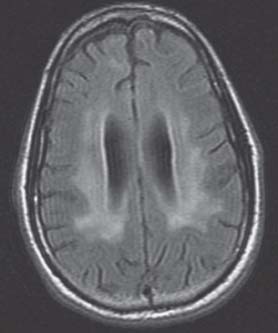Case 111 Progressive Multifocal Leukoencephalopathy Ravi Pande, Maya Nader, and Remi Nader Fig. 111.1 Axial fluid-attenuated inversion-recovery magnetic resonance image of the brain. In this case, his aunt did provide the information that he was in multiple same-sex sexual relationships. Test results obtained are as follows. The patient is human immunodeficiency virus (HIV)-positive with a viral load of 750,000 and a cluster of diff erentiation 4 (CD4) count of 61. Cerebrospinal fluid (CSF) analysis yielded protein level of 105. Polymerase chain reaction (PCR) for JC-virus was negative. CSF immunoglobulin G (IgG) index was high with nine oligoclonal bands (probable markers of demyelination and blood–brain barrier leakage).

 Clinical Presentation
Clinical Presentation
 Questions
Questions
 Answers
Answers
111 Progressive Multifocal Leukoencephalopathy
Case 111 Progressive Multifocal Leukoencephalopathy Fig. 111.1 Axial fluid-attenuated inversion-recovery magnetic resonance image of the brain.

 Clinical Presentation
Clinical Presentation
 Questions
Questions
 Answers
Answers
< div class='tao-gold-member'>
Only gold members can continue reading. Log In or Register to continue
Stay updated, free articles. Join our Telegram channel

Full access? Get Clinical Tree


